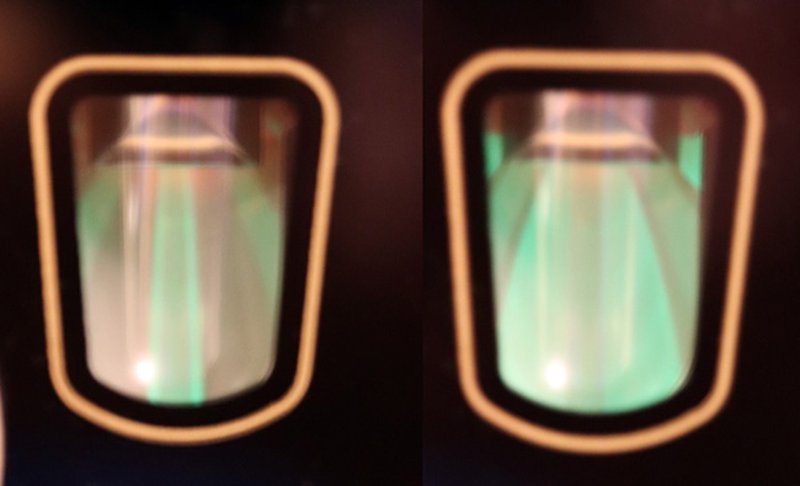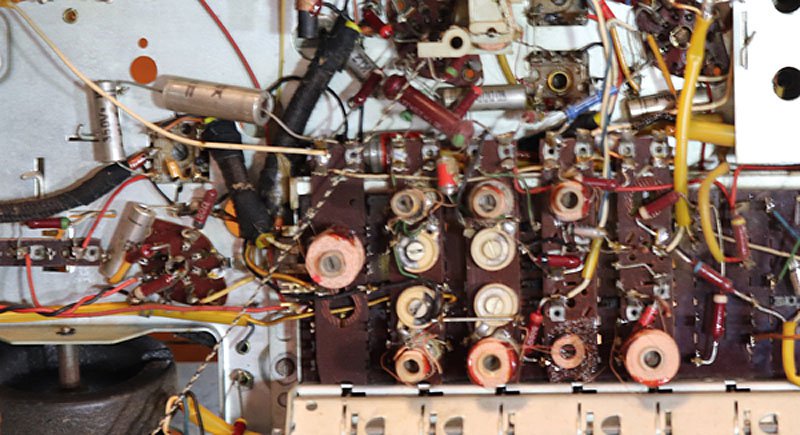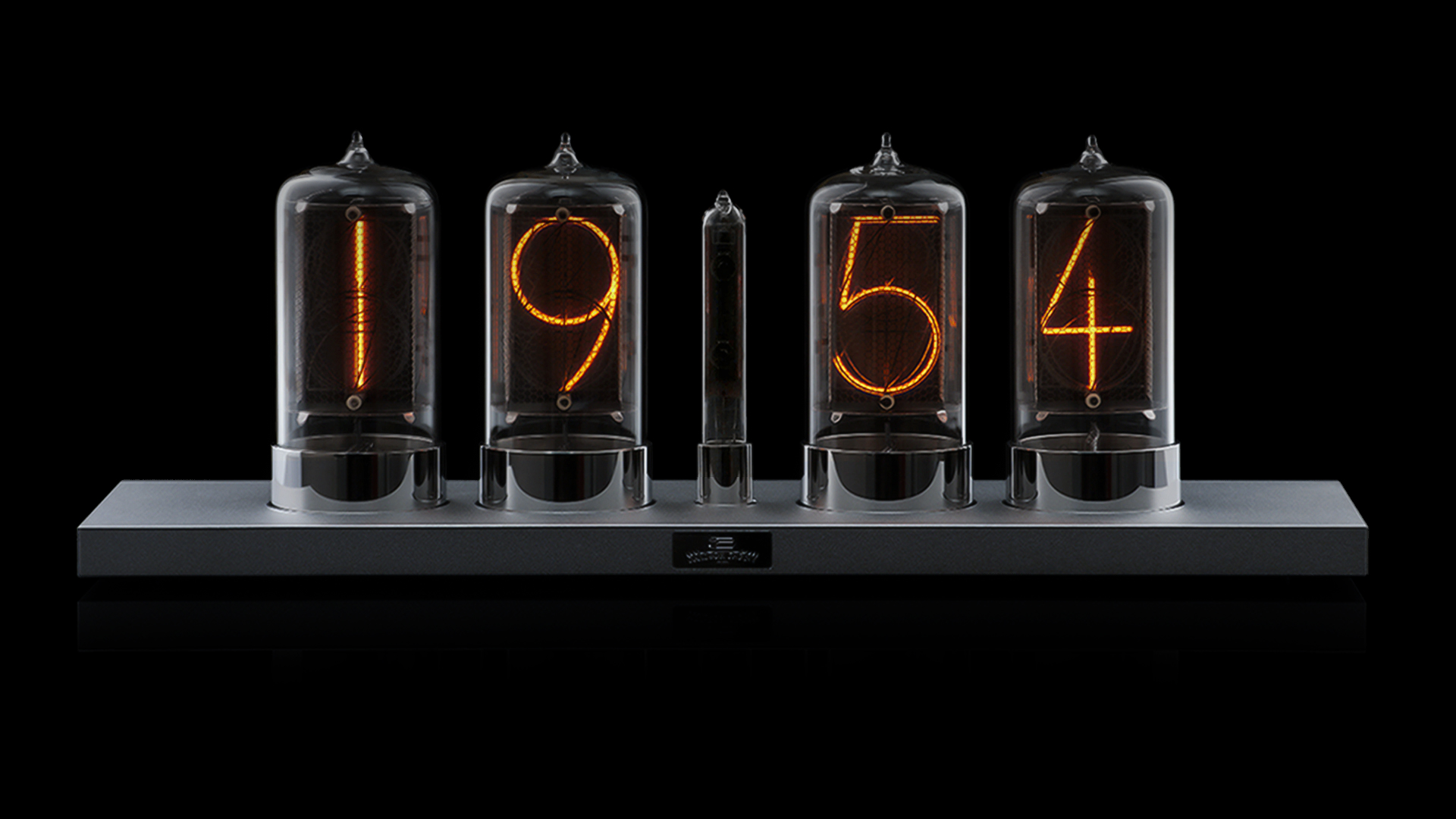-
Hack Chat Transcript, Part 2
01/25/2023 at 21:15 • 0 comments![]() Yeah, he actually doesn't have that much in terms of traditional glassblowing gear. No lathe even.
Yeah, he actually doesn't have that much in terms of traditional glassblowing gear. No lathe even.![]() on tubes and not capacitors :) ....on this piece they used a tube (maybe called a cat's eye) as a receiver strength indicator.....can you talk about those and can I get them for other aesthetic uses?
on tubes and not capacitors :) ....on this piece they used a tube (maybe called a cat's eye) as a receiver strength indicator.....can you talk about those and can I get them for other aesthetic uses?![]() Dalibor is a great guy, love watching his glassblowing skills! We had him on for a Nixie Hack Chat once.
Dalibor is a great guy, love watching his glassblowing skills! We had him on for a Nixie Hack Chat once.![]() ah, Dalibor - makes me wish I worked for him :)
ah, Dalibor - makes me wish I worked for him :)![]() Heh, I used to work in the salvage department of RCA back in the 70's, they had a lathe that could hold a full size picture tube and "re-neck" the tube with a new gun assembly.
Heh, I used to work in the salvage department of RCA back in the 70's, they had a lathe that could hold a full size picture tube and "re-neck" the tube with a new gun assembly.![]() I do not care what others are doing on Hackaday.IO. I want to know what she wants to do and what she needs. The groups on H do not work together. They chat and there is no way to work together effectively. Hacking can be efficient. But not on this site, not these people. All fragmented, useless play. Good people each doing their own thing, never getting together to do anything larger. And so many needs in the world.
I do not care what others are doing on Hackaday.IO. I want to know what she wants to do and what she needs. The groups on H do not work together. They chat and there is no way to work together effectively. Hacking can be efficient. But not on this site, not these people. All fragmented, useless play. Good people each doing their own thing, never getting together to do anything larger. And so many needs in the world.![]() I know of a Polish guy named Aleksander Zawada, he works for a R&D institute in Warsaw and has a lab where he also did experiment with making tubes
I know of a Polish guy named Aleksander Zawada, he works for a R&D institute in Warsaw and has a lab where he also did experiment with making tubes![]()
![]()
![]() EM80 :)
EM80 :)![]() Do you want to work on anything more complex than repairing old radios? Plasma, fusion, accelerators. I work with groups working with gravitational fields. Lots of things happening in the world and not enough people to do them all.
Do you want to work on anything more complex than repairing old radios? Plasma, fusion, accelerators. I work with groups working with gravitational fields. Lots of things happening in the world and not enough people to do them all.![]() hehe tks ! http://www.r-type.org/exhib/aab0151.htm
hehe tks ! http://www.r-type.org/exhib/aab0151.htm![]() @RichardCollins that would be interesting, not for my knowledge yet :)
@RichardCollins that would be interesting, not for my knowledge yet :)![]() @DrG Beautiful, not where is the data? And the models, control systems and guide for applications?
@DrG Beautiful, not where is the data? And the models, control systems and guide for applications?![]() @RichardCollins - sorry you don't like the subject matter, feel free to come back when there's something more to your liking. But please don't continue being disruptive to the people who just want to enjoy the chat
@RichardCollins - sorry you don't like the subject matter, feel free to come back when there's something more to your liking. But please don't continue being disruptive to the people who just want to enjoy the chat![]() I am too old to talk to many people at once. Best wishes. Keri, if you want to, please write to me privately and I will see what I can do.
I am too old to talk to many people at once. Best wishes. Keri, if you want to, please write to me privately and I will see what I can do.![]()
http://www.r-type.org/pdfs/em80.pdf
![]() 6E5 also for 'magic eye' tube
6E5 also for 'magic eye' tube![]() @RichardCollins - sorry man - it is chaotic but don't let gravity get you down :)
@RichardCollins - sorry man - it is chaotic but don't let gravity get you down :)![]()
https://www.radiomuseum.org/tubes/tube_6e5.html
RADIOMUSEUM
ERNST ERB (HB9RXQ)![]()
6E5
Description The RCA tube 6E5 is the first Magic Eye, designed by Allen Balcom Du Mont (born Jan. 29, 1901 in Brooklyn NY, died Nov. 15, 1965 New York NY). Starting 1924 as an engineer for Westinghouse Lamp Company, Bloomfield, NJ, developing manufacturing and testing equipment for vacuum tubes.
![]() a thing of beauty and a joy for ever - also note the base
a thing of beauty and a joy for ever - also note the base![]() old style 6 pins, not octal
old style 6 pins, not octal![]() where do you find odd sockets like the 6 pins above or special 1625 socket? Etsy, eBay, ...?
where do you find odd sockets like the 6 pins above or special 1625 socket? Etsy, eBay, ...?![]() I look for them at online classified sited, other than that, eBay
I look for them at online classified sited, other than that, eBay![]() and I'll also be doing some of my own research into making the Nixie tube sockets by 3D printing - these tubes run cold and while I wouldn't use 3D printing on regular tubes for thermal stability reasons, Nixies should be fine
and I'll also be doing some of my own research into making the Nixie tube sockets by 3D printing - these tubes run cold and while I wouldn't use 3D printing on regular tubes for thermal stability reasons, Nixies should be fine![]() Just be carefull with HV
Just be carefull with HV![]() HV for me is 600V and above... lower than that is the regular stuff, haha
HV for me is 600V and above... lower than that is the regular stuff, haha![]() safety precautions apply
safety precautions apply![]() Who is building new equipment with tubes other than @Keri Szafir ? I recently built a portable QRP 40 meter transmitter. Runs on a 12V 3aHr LiFePo battery . Uses a Nixie supply to boost 12V to 215V, it is also RF quiet.
Who is building new equipment with tubes other than @Keri Szafir ? I recently built a portable QRP 40 meter transmitter. Runs on a 12V 3aHr LiFePo battery . Uses a Nixie supply to boost 12V to 215V, it is also RF quiet.![]() nice :)
nice :)![]() There's always David Lovett over at Usagi Electric. He's making a vacuum tube computer
There's always David Lovett over at Usagi Electric. He's making a vacuum tube computer![]() The relay computer is also very cool (and noisy)
The relay computer is also very cool (and noisy)![]() @phase2682 - have you put up a build log of that? I'd love to take a look and maybe write it up for the blog
@phase2682 - have you put up a build log of that? I'd love to take a look and maybe write it up for the blog![]() I admire Dave! been part of his community for over a year
I admire Dave! been part of his community for over a year![]() @Dan Maloney I have not posted anything yet but will notify you when I do.
@Dan Maloney I have not posted anything yet but will notify you when I do.![]() oh, and I also admire Sam Battle (Look Mum, No Computer!) and his mad creations :)
oh, and I also admire Sam Battle (Look Mum, No Computer!) and his mad creations :)![]() Thanks!
Thanks!![]() Dropping off, it has been fun. Glad to see others are also interested in vintage electronics.
Dropping off, it has been fun. Glad to see others are also interested in vintage electronics.![]() nice - see you! :)
nice - see you! :)![]() Yeah, we're about out of time -- must be getting late in Europe by now anyway. We'll just say a big thanks to Keri for her time today, this was really interesting. So many old gear lovers out there, it's cool!
Yeah, we're about out of time -- must be getting late in Europe by now anyway. We'll just say a big thanks to Keri for her time today, this was really interesting. So many old gear lovers out there, it's cool!![]() Outatime!
Outatime!![]() Keri, thanks so much for your time. I looked into some of your links and I was impressed and very happy that you were willing to share some of your expertise. - Thanks also Dan for, yet, another one :).
Keri, thanks so much for your time. I looked into some of your links and I was impressed and very happy that you were willing to share some of your expertise. - Thanks also Dan for, yet, another one :).![]() is it 1985 yet?
is it 1985 yet?Thank you @Keri Szafir
![]() And thanks to everyone else for the great questions!
And thanks to everyone else for the great questions!And thank you @Dan Maloney for hosting it! :-)
![]() Thanks Keri and everyone!
Thanks Keri and everyone!![]() just an hour? ha, I thought it'd be longer :) and it's 22:02 in my TZ now
just an hour? ha, I thought it'd be longer :) and it's 22:02 in my TZ now![]() not that late :)
not that late :)![]() Thank you all for this chat. Very interesting
Thank you all for this chat. Very interesting![]() thanks for kind words :)
thanks for kind words :)![]() I mean, feel free to stay on -- Hack Chat is always open!
I mean, feel free to stay on -- Hack Chat is always open!![]() @Keri Szafir Thank you for all you do!! You keep inspiring ameteurs like myself!! Be safe!
@Keri Szafir Thank you for all you do!! You keep inspiring ameteurs like myself!! Be safe!![]() always drain those caps AND measure the voltage before you work on the tube stuff!
always drain those caps AND measure the voltage before you work on the tube stuff! -
Hack Chat Transcript, Part 1
01/25/2023 at 21:15 • 0 comments![]() OK folks, it's tube time! I'm Dan, I'll be modding today along with Dusan as we welcome Keri Szafir to the Vintage Electronics Hack Chat!
OK folks, it's tube time! I'm Dan, I'll be modding today along with Dusan as we welcome Keri Szafir to the Vintage Electronics Hack Chat!Hi Keri, are you online yet?
![]() Hi @Dan Maloney !
Hi @Dan Maloney !![]() Technical difficulties, please stand by...
Technical difficulties, please stand by...![]() Hi Bil!
Hi Bil!![]() Just trying to get the chat rooms sorted out
Just trying to get the chat rooms sorted outHi @Bil Herd
![]() Hi Boian!
Hi Boian!![]() hello everyone :)
hello everyone :)![]() first time on HC, I got the rooms wrong :)
first time on HC, I got the rooms wrong :)![]() Hi!
Hi!![]() Hey Keri, welcome aboard!
Hey Keri, welcome aboard!![]() haha, nice seeing you :)
haha, nice seeing you :)![]() Can you tell us a little about how you fell into the Dark Arts of old gear?
Can you tell us a little about how you fell into the Dark Arts of old gear?![]() I was learning electronics in my teens in the '90s, and never having too much cash, I couldn't just go to a parts shop and buy new - I mostly salvaged them from old devices, so old stuff was no new to me even back then
I was learning electronics in my teens in the '90s, and never having too much cash, I couldn't just go to a parts shop and buy new - I mostly salvaged them from old devices, so old stuff was no new to me even back then![]() Is there an audio visual aspect to this chat? Feel like I'm missing something...
Is there an audio visual aspect to this chat? Feel like I'm missing something...![]() Nope, we just roll old school and do text chat.
Nope, we just roll old school and do text chat.![]()
Keri Szafir's Profile
For getting out of my tiny lab to the broader world! Your regular mad scientist's plot to conquer the world. I've been building electronics for most of my life... Vacuum tube amps (guitar & hi-fi), vintage gear restorations, audio stuff, test gear, automation, fun projects etc. both for myself and for an occassional customer.
![]() Although we can post pix and links, ofc
Although we can post pix and links, ofc![]() vintage, as in vacuum tubes? it was more like early 2000s (2003 or so) when I was at high school; I was fascinated by Fallout 1 & 2, with the '50s retro-futuristic aesthetics, all tube stuff (semiconductors were not invented in the alternate timeline the game's world took after WWII) and this got me into an interest in old Civil War era electronics, restoring and repairing devices, building my own inspired by the past
vintage, as in vacuum tubes? it was more like early 2000s (2003 or so) when I was at high school; I was fascinated by Fallout 1 & 2, with the '50s retro-futuristic aesthetics, all tube stuff (semiconductors were not invented in the alternate timeline the game's world took after WWII) and this got me into an interest in old Civil War era electronics, restoring and repairing devices, building my own inspired by the past![]() Old TVs were always a great source of parts for me. Just don't forget to discharge the caps!
Old TVs were always a great source of parts for me. Just don't forget to discharge the caps!![]() when I was learning electronics tubes were easy to get, ICs and transistors less so. Everyone was throwing out their B/W TV for Color TVs
when I was learning electronics tubes were easy to get, ICs and transistors less so. Everyone was throwing out their B/W TV for Color TVs![]() I am older than transistors. In the 60's there were lots of vacuum tube devices and resources. By the 90's a lot of that was gone and inaccessible.
I am older than transistors. In the 60's there were lots of vacuum tube devices and resources. By the 90's a lot of that was gone and inaccessible.![]() I got acquainted with a bunch of guitarists and did amp service and building for them too, that's how I got into almost living and breathing old tech
I got acquainted with a bunch of guitarists and did amp service and building for them too, that's how I got into almost living and breathing old tech![]() I never did TVs, though I liked restoring radios
I never did TVs, though I liked restoring radios![]() Keri, have you "evolved" toward early digital? I have questions on both :)
Keri, have you "evolved" toward early digital? I have questions on both :)![]() Most of my builds were for Ham Radio, there were still WWII surplus parts available as well. 1625s made for great finals
Most of my builds were for Ham Radio, there were still WWII surplus parts available as well. 1625s made for great finals![]() I can never resist a good Hamfest :-)
I can never resist a good Hamfest :-)![]() I've been hitting thrift stores looking for restoration-worthy tube radios, but alas...
I've been hitting thrift stores looking for restoration-worthy tube radios, but alas...![]() Cool, yeah I repair tube amps for many musicians. I've got some old Silvertone amps on my bench now.... there are parts in this thing I've never seen, like a big Condensor. What the hell is that?
Cool, yeah I repair tube amps for many musicians. I've got some old Silvertone amps on my bench now.... there are parts in this thing I've never seen, like a big Condensor. What the hell is that?![]() What's the best way to discharge those old caps?
What's the best way to discharge those old caps?![]() @DrG kinda, I sometimes worked with DTL
@DrG kinda, I sometimes worked with DTL![]() Hamfests and swap meets tend to have vintage radios at better prices than other sources. Just be ready to negotiate and walk away
Hamfests and swap meets tend to have vintage radios at better prices than other sources. Just be ready to negotiate and walk away![]() @Keri Szafir do you have any favorite boxes or websites for learning old school electronics like vacuum tubes, tube radios or maybe even nixie tubes?
@Keri Szafir do you have any favorite boxes or websites for learning old school electronics like vacuum tubes, tube radios or maybe even nixie tubes?![]() @Dan Maloney Hamfests and swap meets tend to have vintage radios at better prices than other sources. Just be ready to negotiate and walk away
@Dan Maloney Hamfests and swap meets tend to have vintage radios at better prices than other sources. Just be ready to negotiate and walk away![]() speaking of hamfests, I had an electronics fleamarket in my old city - that's where I got quite a lot of stuff, anything I could afford (and cash was always a problem), tubes, sockets, potentiometers, whatnot... and I wish I could grab more cheap Soviet tubes imported by Belarussian or Ukrainian guys who sold them here in Poland
speaking of hamfests, I had an electronics fleamarket in my old city - that's where I got quite a lot of stuff, anything I could afford (and cash was always a problem), tubes, sockets, potentiometers, whatnot... and I wish I could grab more cheap Soviet tubes imported by Belarussian or Ukrainian guys who sold them here in Poland![]() ok - question - I am the proud (and accidental) owner of a Blaupunkt Barcelona (1957 I suppose) it works well and I have done only minimal repair and cleaning - do I have to change all those caps?
ok - question - I am the proud (and accidental) owner of a Blaupunkt Barcelona (1957 I suppose) it works well and I have done only minimal repair and cleaning - do I have to change all those caps?![]() @Lt.Slothrop Jogis Roehrenbude would be my favorite tube-related website, and there's Frank's catalog I use for reference
@Lt.Slothrop Jogis Roehrenbude would be my favorite tube-related website, and there's Frank's catalog I use for reference![]() other than that, Youtube of course, my #1 being Mr Carlson's Lab
other than that, Youtube of course, my #1 being Mr Carlson's Lab![]()
https://www.vintage-radio.info/docs
Vintage Radio Documents and Articles
A selection of scanned technical and historic documents and magazine articles that should be of interest to vintage radio collectors etc. 31 files available. Click a row in the table below to download the file. You may download up to 10 different files in a 15 minute period.
![]()
http://www.tubebooks.org/Books/RDH4.pdf
![]() +100 for Mr. Carlson! I really like his new lab, too!
+100 for Mr. Carlson! I really like his new lab, too!![]() DTL - Drift Tube Lineacs?
DTL - Drift Tube Lineacs?Do you make your own tubes?
![]()
https://www.youtube.com/@RestoreOldRadios
RestoreOldRadios
Thanks for checking out my channel. I enjoy restoring old radios from the 30's through the 40's as a hobby when time permits. For those just getting started in vintage and/or antique radio repair/restorations, I hope you find the videos to be entertaining with a few tips inserted from time to time.
![]() as for caps - discharge them through a resistor (e.g. 10k 2W), change if there's visibly something wrong with them (bulges, deteriorated sealing etc.) or if tested and working wrong
as for caps - discharge them through a resistor (e.g. 10k 2W), change if there's visibly something wrong with them (bulges, deteriorated sealing etc.) or if tested and working wrong![]() @Keri Szafir where do you buy your caps for tube amplifiers?
@Keri Szafir where do you buy your caps for tube amplifiers?![]() and watch out for hot chassis on transformerless tube radios
and watch out for hot chassis on transformerless tube radios![]() I mostly use vintage caps for my own builds, or buy new in some electronics parts stores
I mostly use vintage caps for my own builds, or buy new in some electronics parts stores![]() oh yeah, hot chassis... I always use extra precautions for these
oh yeah, hot chassis... I always use extra precautions for these![]() https://www.justradios.com/ has a lot parts and good infor on their website
https://www.justradios.com/ has a lot parts and good infor on their website![]() Do you have a hard limit for replacing caps in terms of date? IOW, they may look fine, but teething was built in 1960 so just replace them?
Do you have a hard limit for replacing caps in terms of date? IOW, they may look fine, but teething was built in 1960 so just replace them?![]() There must be a way to test caps, no?
There must be a way to test caps, no?![]() ESR meter, right?
ESR meter, right?![]() I think Dan is getting at why I asked...I get told that they all need to be replaced because they will blow and make a nasty mess.
I think Dan is getting at why I asked...I get told that they all need to be replaced because they will blow and make a nasty mess.![]() I don't blanket replace caps, do it on a case-by-case basis, test for capacitance and ESR
I don't blanket replace caps, do it on a case-by-case basis, test for capacitance and ESR![]() I'll also build a leakage tester - a useful tool
I'll also build a leakage tester - a useful tool![]() I would think the less R&R you could do to an older piece of tech the better
I would think the less R&R you could do to an older piece of tech the better![]() @Dan Maloney I replace electrolytics from 1970s and before. Any paper wax capacitor goes away as well. I have an old Heathkit cap tester but I found it tends to reform old electrolytic capacitors when testing. So I just replace the electrolytic capacitors so I don't have to go back later.
@Dan Maloney I replace electrolytics from 1970s and before. Any paper wax capacitor goes away as well. I have an old Heathkit cap tester but I found it tends to reform old electrolytic capacitors when testing. So I just replace the electrolytic capacitors so I don't have to go back later.![]() oh yeah, especially very old stuff (pre-WWII, though I never had one on my bench); in that case I'll restuff the old can with modern components to preserve the visual originality AND not add anything modern on the bottom part of the chassis
oh yeah, especially very old stuff (pre-WWII, though I never had one on my bench); in that case I'll restuff the old can with modern components to preserve the visual originality AND not add anything modern on the bottom part of the chassis![]() paper wax goes, no questions asked - these parts were utterly crappy and prone to failure
paper wax goes, no questions asked - these parts were utterly crappy and prone to failure![]() Keri - that's an interesting idea
Keri - that's an interesting idea![]() I had an old Hallicrafters that I recapped in the early '80s and had to replace the electrolytics again a few years ago
I had an old Hallicrafters that I recapped in the early '80s and had to replace the electrolytics again a few years ago![]() who would have thought that we would outlive capacitors
who would have thought that we would outlive capacitors![]() back then things were often built to last, though you're never sure - always check it!
back then things were often built to last, though you're never sure - always check it!![]() The technology for capacitors has come a long way over the last few decades. That is why you can stuff old cans with new capacitors and have space left over
The technology for capacitors has come a long way over the last few decades. That is why you can stuff old cans with new capacitors and have space left over![]() I like Keri's intro where she talks about smells, fixing things in the old days was deffinately a multi-sensory experience.
I like Keri's intro where she talks about smells, fixing things in the old days was deffinately a multi-sensory experience.![]() oh yeah
oh yeah![]() I am impressed with anyone that takes the time and effort to restuff old components. @Keri Szafir My restores are usually not that valuable or historically significant.
I am impressed with anyone that takes the time and effort to restuff old components. @Keri Szafir My restores are usually not that valuable or historically significant.![]() I love when someone restuffs those big old can caps for a restoration. Such attention to detail!
I love when someone restuffs those big old can caps for a restoration. Such attention to detail!![]() that's how I'd do it on something remarkable - other than that, I'd probably use a vintage cap from my stash
that's how I'd do it on something remarkable - other than that, I'd probably use a vintage cap from my stash![]() I am personally VERY impressed with the careful point-to-point component soldering that I see in that radio....and of course, the schematic was included. It was built with quality.
I am personally VERY impressed with the careful point-to-point component soldering that I see in that radio....and of course, the schematic was included. It was built with quality.The problem for me conceptually is when does a restoration mean no longer original - I guess always...but better to have it working.
![]() When restoring do folks usually test the tubes or only if the equipment doesn't work?
When restoring do folks usually test the tubes or only if the equipment doesn't work?![]()
![]()
![]() blows me away going through it
blows me away going through it![]() I agree that it's better to have it working at all. Maintaining the original aesthetics on the interior is a major bonus
I agree that it's better to have it working at all. Maintaining the original aesthetics on the interior is a major bonus![]() I test tubes on amps, and when something's wrong, on radios too
I test tubes on amps, and when something's wrong, on radios too![]() Just think about how labor-intensive it was to mass produce electronics before PCB construction. Blows the mind...
Just think about how labor-intensive it was to mass produce electronics before PCB construction. Blows the mind...![]() oh yes - and it was mainly ladies who did it!
oh yes - and it was mainly ladies who did it!![]() That is why TVs and Radios were expensive back in the day, a family only had one
That is why TVs and Radios were expensive back in the day, a family only had one![]() And they did it fast, too. I think it was mostly piecework, so they got paid by the chassis
And they did it fast, too. I think it was mostly piecework, so they got paid by the chassisNot to melon manually programming Rope memory... ;-)
![]() oh yes, ferrite core memory...
oh yes, ferrite core memory...![]() Is this a chat about capacitors or vacuum tubes?
Is this a chat about capacitors or vacuum tubes?Can you reproduce the Franck-Hertz experiment for class room use in high schools, colleges and universities world-wide? https://en.wikipedia.org/wiki/Franck%E2%80%93Hertz_experiment
![]() It's a chat about vintage electronics, so - yes!
It's a chat about vintage electronics, so - yes!![]() Can you make your own vacuum tubes?
Can you make your own vacuum tubes?![]()
wells gardner story.pdf
4 MB
![]() I can't - don't have the lab for that
I can't - don't have the lab for that![]() What would you need?
What would you need?![]() Wells Gardner story with radio assembly photos
Wells Gardner story with radio assembly photos![]() Glass lathe, glass blowing equipment, vaccum pump
Glass lathe, glass blowing equipment, vaccum pump![]() And the metal pieces doped with sometime dangerous materials
And the metal pieces doped with sometime dangerous materials![]() Is there a university near you or research facility? I could write and recommend they help you. Or you can start a crowdfund.
Is there a university near you or research facility? I could write and recommend they help you. Or you can start a crowdfund.![]() I'd need materials (barium oxide cathodes for indirectly heated, or tungsten for directly heated), metals for electrodes, glass, high vacuum pump setup, getters, burners for glassworking...
I'd need materials (barium oxide cathodes for indirectly heated, or tungsten for directly heated), metals for electrodes, glass, high vacuum pump setup, getters, burners for glassworking...![]() lots of expensive materials
lots of expensive materials![]() Others are building their own tubes, been posted in Hackaday
Others are building their own tubes, been posted in Hackaday![]() This guy:
This guy:![]()
https://hackaday.com/2022/10/27/a-homemade-tube-amplifier-featuring-homemade-tubes/
A Homemade Tube Amplifier Featuring Homemade Tubes
With the wealth of cheap and highly integrated audio amplifier modules on the market today, it takes a special dedication to roll your own from parts. Especially when those parts include vacuum tubes, and doubly so when you make the vacuum tubes from scratch too.
![]() ah, jdflyback :)
ah, jdflyback :)![]() How much would it cost? Could you improve on vacuum tube technolgy using new methods of design? What from the past would help. Thanks Dan
How much would it cost? Could you improve on vacuum tube technolgy using new methods of design? What from the past would help. Thanks Dan![]()
NIXIE TUBE & CLOCK MANUFACTURER
![]()
Nixie Tube & Clock Manufacturer
Today, we're running a small-scale production The distinct look and functionality of our Nixie tubes trail years of design, testing, and refinement. Each is produced in a laboratory setting, with hopes to one day employ large-scale production means to ensure access for everyone.
Read this on Nixie Tube & Clock Manufacturer
![]() In tube technology, I think the only thing that improved is the level of accuracy
In tube technology, I think the only thing that improved is the level of accuracy![]()
 Lutetium
Lutetium
















